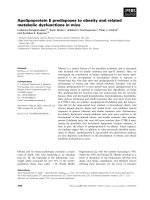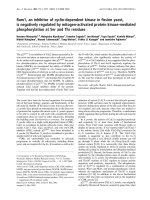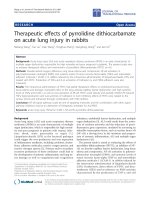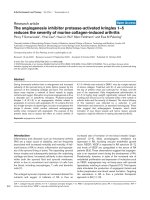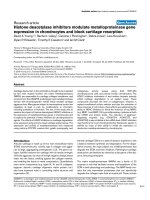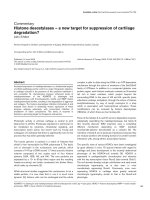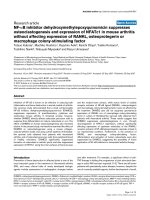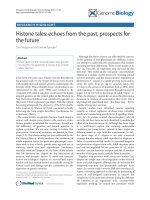Báo cáo y học: "Histone deacetylase inhibitor, butyrate, attenuates lipopolysaccharide-induced acute lung injury in mice" pptx
Bạn đang xem bản rút gọn của tài liệu. Xem và tải ngay bản đầy đủ của tài liệu tại đây (2.14 MB, 8 trang )
RESEA R C H Open Access
Histone deacetylase inhibitor, butyrate,
attenuates lipopolysaccharide-induced acute
lung injury in mice
Yun-Feng Ni
†
, Jian Wang
†
, Xiao-Long Yan, Feng Tian, Jin-Bo Zhao, Yun-Jie Wang
*
, Tao Jiang
*
Abstract
Background: Histone deacetylase (HDAC) inhibitors, developed as promising anti-tumor drugs, exhib it their anti-
inflammatory properties due to their effects on reduction of inflammatory cytokines.
Objective: To investigate the protective effect of butyrate, a HDAC inhibitor, on lipopolysaccharide (LPS)-induced
acute lung injury (ALI) in mice.
Methods: ALI was induced in Balb/c mice by intratracheally instillation of LPS (1 mg/kg). Before 1 hour of LPS
administration, the mice received butyrate (10 mg/kg) orally. The animals in each group were sacrificed at different
time point after LPS administration. Pulmonar y histological changes were evaluated by hematoxylin-eosin stain and
lung wet/dry weight ratios were observed. Concentration s of interleukin (IL)-1b and tumor necrosis factor (TNF)-a
in bronchoalveolar lavage fluid (BALF) and concentrations of nitric oxide (NO) and myeloperoxidase (MPO) activity
in lung tissue homogenates were measured by enzyme-linked immunosorbent assay (ELISA). Expression of nuclear
factor (NF)-B p65 in cytoplasm and nucleus was determined by Western blot analysis respectively.
Results: Pretreatment with butyrate led to significant attenuation of LPS induced evident lung histopathological
changes, alveolar hemorrhage, and neutrophils infiltration with evidence of reduced MPO activity. The lung wet/dry
weight ratios, as an index of lung edema, were reduced by butyrate administration. Butyrate also repressed the
production of TNF-a, IL-1b and NO. Furthermore, the expression of NF-B p65 in nucleus was markedly suppressed
by butyrate pretreatment.
Conclusions: Butyrate had a protective effect on LPS-induced ALI, which may be related to its effect on
suppression of inflammatory cytokines production and NF-B activation.
Background
Acute lung injury (ALI) and acute respiratory distress
syndrome (ARDS) are well defined and readily recog-
nised clinical disorders caused by many clinical insults
to the lung or because of predispositions to lung injury
[1]. Sepsis and pneumonia are the main causes of ALI
clinically. ALI occurring during gram-negative bacterial
pneumonia and sepsis is caused in large part by lipo-
polysaccharide (LPS), a component of the cell walls o f
gram-negative bacteria [2]. When the cells in lung are
exposed to LPS, the nuclear factor (NF)-B is activated.
NF-B is a protein transcription factor that functions to
enhance the transcription of a variety of genes, including
cytokines and growth factors, adhesion molecules,
immunoreceptors, and acute-phase proteins [3]. Upon
activation by LPS, NF-B is required for maximal tran-
scription of many cytokines, including tumor necrosis
factor (TNF)-a, interleukin (IL)-1b, IL-6, and IL-8,
which are thought to be imp ortant in the generation of
ALI. These cytokines and chemo kines contribute to the
vigorous recruitment of neutrophils in lung. Therefore,
ALI is substantially caused by excessive neutrophil- and
cytokine-mediated inflammation. Despite advancement
in understanding the path ophysiology of ALI/ARDS and
improved therapy methods, however, mortality rates of
ALI/ARDS are around 40% [4].
* Correspondence: ;
† Contributed equally
Department of Thoracic Surgery, Tangdu Hospital, Fourth Military Medical
University, Xi’an 710038, PR China
Ni et al. Respiratory Research 2010, 11:33
/>© 2010 Ni et al; licensee BioMed Central Ltd. This is an Open Access article distri buted un der the terms of the Creative Commons
Attribution License ( which perm its unrestricted use, distribution, and reproduction in
any medium, provided the original work is properly cited.
Histone deacetylases (HDACs) regulate gene expres-
sion. In general, inhibitors of HDACs result in a non-
specific increase in gene expression. Therefore, they are
considered as a new class of therapeutic agents for the
treatment of tumor [5]. Agents such as trichostatin A
(TSA) or suberoylanilide hydroxamic acid (SAHA)
induce differentiation and/or apoptosis of transformed
cells in vitro and inhibit tumor growth in vivo [6]. An
unexpected effect of HDAC inhibitors, however, was
revealed by recent studies indicating that they are able
to suppress transcription and reduce inflammator y cyto-
kines in models of autoimmune and inflammatory dis-
eases [7,8]. Butyrate, a HDAC inhibit or, is a short-chain
fatty acid derived from bacterial metabolism of dietary
fibers in the colon and produces cell cycle arrest, differ-
entiation and/or apoptosis of colorectal cancer cells in
vitro [9-13]. Previous study has shown that butyrate
reduced inflammation in Crohn’s disease through NF-
B in hibition [14]. To date, unfortunately, the protective
role of HDAC inhibitors in ALI is not well
characterized.
The aims of this study were to investigate whether
butyrate reduces inflammation in LPS-induced ALI
in mice and to determine whether the protective effect
is produced by suppression of inflammatory cytokines
production and NF-B activation.
Materials and met hods
Animals and Reagents
Male BALB/C mi ce weighing 20-25 g were purchased
from the Animal Center of the Fourth Military Medical
University (Xian, China). All anim als were allowed to
take food and tap water ad libitum. All procedures were
in accordance with the Declaration of Helsinki of the
World Medical Association. The protocols were also
approved by the Institutional Animal Care and Use
Committee of the Fourth Military Medical University
Tangdu Hospital. LPS (Escherichia coli lipopolysacchar-
ide, 055:B5) and butyrate were obtained from Sigma
Chemical Company (St. Louis, MO., USA), and were
respectively dissolved in saline (1 mg/ml and 2 mg/ml).
Enzyme-linked immunosorbent assay (ELISA) kits of
TNF-a,IL-1b, myeloperoxidase (MPO) and nitric oxide
(NO) were purchased from R&D Corporation (R&D
Systems Inc. Minneapolis, MN, USA). Antibodies speci-
fic for total NF-B p65, Lamin B and b-actin were
obtained from the Wuhan Boster Biological Technology,
Ltd. (Wuhan, China). Nuclear and cytoplasmic protein
extraction kit was purchased from Beyotime Institute of
Biotechnology (Beijing, China). BCA protein assay kit
was obtained from Thermo Scientif ic Pierce Protein
Research Products (Rockford, IL., USA).
Experimental Protocol
All animals were randomly divided into 4 groups (n =
15, each group). Group 1 (control group) received an
intratracheal injection of saline, group 2 (butyrate
group) rece ived an intragastric injecti on of but yrate (10
mg/kg), group 3 (LPS group) received an intratracheal
instillation of LPS (1 mg/kg), and group 4 (LPS + buty-
rate group) received an intragastric injection of buty-
rate (10 mg/kg) 1 hour before LPS administration. At
differenttimepoint(1,3,6,12and24hours)after
administration, all animals were sacrificed. Bronchoal-
veolar lavage (BAL) was performed through the left
lung. The superior lobe of right lung was excised for
histopathologic examination. The middle lobe of right
lung was excised for analysis of lung wet/dry weight
ratio. The lower lobe of right lung was rapidly removed
and cut into two parts in same size. A part of the
lower lobe was homogenized and frozen in a cold
phosphate solution at -80°C for MPO and NO analysis,
and the another part was used to extract cyt oplasmic
and nuclear proteins for Western blot analysis.
BAL
Animals were anesthetized with intraperitoneal pento-
barbital (50 mg/kg). A median sternotomy allowed for
exposure of both of the lungs. The trachea was exposed
and inserte d with an intravenous infusion needle. A fter
ligating the hilum of right lung, the left lung was
lavaged 5 times with 0.5 ml ice-cold phosphate buf-
fered saline. The recovery ratio of the fluid was about
90%. The BAL fluid (BALF) was immediately centri-
fuged at 500 × g for 10 minutes at 4°C, and the cell-
free supernatant was stored at -80°C for analysis of
cytokines.
MPO and NO Assays
To carry out the assays, tissue samples were subjected
to three further freeze-thaw cycles and centrifuged at
12 000 × g for 10 minutes at 4°C. The supernatant was
assayed for MPO activity and NO concentrations with
ELISA kits. All procedures were done in accordance
with the manufacturer’s instructions.
TNF-a and IL-1b Assays
Concentrations of TNF-a and IL-1b in BALF were mea-
sured by using ELISA kits. All procedures were done in
accordance with the manufacturer’s instructions.
Lung wet/dry weight ratio
As an index of lung edema, the amount of extravascular
lung water was calculated. The middle lobe of right lung
was excised and the wet weight was recorded. The lung
Ni et al. Respiratory Research 2010, 11:33
/>Page 2 of 8
was then placed in an incubator at 80 °C for 24 hours to
obtain the dry weight. And the wet/dry weight ratios
were calculated by dividing the wet weight by the dry
weight.
Pulmonary Histopathology
Thesuperiorlobeofrightlungwasharvestedat24
hours after LPS administration and fixed with an intra-
tracheal instillation of 1 ml buffered formalin (10%, PH
7.2). The lobe was further fixed in 10% neutral buffered
formalin for 24 hours at 4°C. The tissues were
embedded in paraffin and cut into 5 μm sections.
Hematoxylin-eosin stains were performed using stan-
dard protocol.
Western Blot Analysis
The lower lobe of right lung in each mouse was har-
vested separately at 1, 3, 6, 12 and 24 hours after LPS
administrationandfrozeninliquidnitrogenimmedi-
ately until homogenization. Tis sue samples were homo-
genized and the cytoplasmic and nucle ar proteins were
extracted respectively according to instructions of
Nuclear and Cytoplasmic Protein Extraction Kit. Protein
concentrations were determined by BCA protein assay
kit. Samples were separated on a denaturing 12% pol-
yacrylamide gel and transferred to a nitrocellulose
membrane. NF-B p65 protein was detected by chemi-
luminescence using a rabbit polyclonal antibody accord-
ing to the manufacturer’s instructions.
Statistical analyses
Data were entered into a database and analyzed using
SPSS software, and expressed as means ± SEM. Statisti-
cally significant differences betwe en groups were deter-
mined by ANOVA followed by Student’ sttest.
Significance was accepted when p < 0.05.
Results
Effect of Butyrate on MPO Activity and NO
Concentrations in Lung Tissues of Mice with ALI
After LPS administration, t he MPO activity in lung tis-
sues was significantly and continuously increased com-
pared with the control and butyrate groups from 1 to
24 hours (fig. 1A). In addition, the concentrations of
NO were significantly increased at 1 hour and peaked at
3 hours after LPS administration (fig. 1B). However, in
LPS + butyrate group, butyrate pretreatment m arkedly
decreased the MPO activity and NO concentrations at
different time point (fig. 1A and 1B).
Effect of Butyrate on the Concentrations of TNF-a and
IL-1b in BALF of Mice with ALI
The concentrations of TNF-a and IL-1b in BALF were
significantly increased at 1 hour and peaked at 3 hours
after LPS administration (fig. 2A and 2B). Butyrate pre-
treatment efficiently reduced the production of TNF-a
and IL-1b at different time point (fig. 2A and 2B).
Effect of Butyrate on the Lung edema of Mice with ALI
Compared with the control and butyrate groups, the
lung wet/dry weight ratios were significantly and con-
tinuously increased from 1 to 24 hours after LPS admin-
istration. The increase of the lung wet/dry weight rati os
was significantly reduced by butyrate administration at
different time point (fig. 3).
Effect of Butyrate on the Pulmonary Histopathological
Changes of Mice with ALI
Lung tissues from the control and butyrate groups
showed a normal structure and no histopathological
changes under a light microscope (fig. 4A and 4B). In
LPS group, the lungs stained with hematoxylin-eosin
indicated widespread alve olar wall thickness caused by
Figure 1 Effect of butyrate on MPO activity and NO concentrations in lung tissues of mice with ALI. A. The MPO activity in lung tissues
at each time point after LPS administration and the effect of butyrate pretreatment. B. The concentrations of NO in lung tissues at each time
point after LPS administration and the effect of butyrate pretreatment. Data are expressed as mean ± SEM, *P < 0.05 vs. control and butyrate
group;
#
P < 0.05 vs. LPS group.
Ni et al. Respiratory Research 2010, 11:33
/>Page 3 of 8
edema, seve re hemorrhage in the alveolus, alveolus col-
lapse and obvious inflammatory cells infiltration (fig. 4C).
In LPS + butyrate group, the histopathological changes of
lung were minor compared with those in LPS group,
especially in inflammatory cells infiltration (fig. 4D).
Effect of Butyrate on the Activation of NF-B in Lung
Tissues of Mice with ALI
After LPS administration, the expression of NF-Bp65
in nucleus markedly increased and peaked at 3 hours
(fig. 5B and 5D). The expression of NF-Bp65in
nucleus i nduced by LPS was significantly suppressed at
1, 3 and 6 hours by butyrate pretreatment (fig. 5C and
5D). On the contrary, the expression of NF-Bp65in
cytoplasm was significantly reduced by LPS administra-
tion (fig. 6B and 6D), and these changes were inhibited
by butyrate pretreatment (fig. 6C and 6D). No changes
of expression of NF-B p65 in cy toplasm (fig. 6A and
6D) and nucleus (fig. 5A and 6D), same as control
group, were observed with administration of butyrate
alone at each time point.
Discussion
The different results were observed in previous studies
in vitro in terms of HDAC inhibitors’ anti-inflammatory
effects. ITF2357, a HDAC inhibitor, reduced IL-1, TNF-
a and interferon-g expression in LPS-stimulated human
peripheral blood mononuclear cells [15]. Butyrate also
reduced IL-12 production b y human blood monocytes,
and inhibited NO production in RAW macrophage cells
[16,17]. However, pharmacological inhibition of HDAC
increased the release of the pro-inflammatory cytokine
IL-8 in human alveolar epithelial cells (A549) treated by
TNF-a [18]. Moreover, TSA enhanced IL-8 production
in SV-40-transformed lung epithelial cells stimulated by
LPS [19].
Based on the results observed in lung epithelial cells,
HDAC inhibitors seemed to be pro-inflammatory in
ALI. In the present study, interestingly, our results indi-
cated that administration of butyrate in vivo attenuated
pulmonary inflammation in LPS-induced ALI. The r ea-
son for the discrepancy may be related to the different
circumstances in vitro and in vivo. Furthermore,
although the alveolar epithelial cells are the main part of
lung tissues, the alveolar macrophages and neutrophils
play a central role in ALI but not alveolar epithelial
cells, which may contribute to the discrepancy. Consis-
tent with the present study, TSA attenuated the devel-
opment of allergi c airway inflammation by decreasing
expression of the Th2 cytokines, IL-4 and IL-5, reduced
spinal cord inflammation, d emyelination, neuronal and
axonal loss, and ameliorated di sability in the relapsing
phase of experimental autoimmune encephalomyelitis, a
model of multiple sclerosis [20,21]. Therefore, different
Figure 2 Effect of butyrate on the concentrations of TNF-a and IL-1b in BALF of mice with ALI. A. The concentrations of TNF-a in BALF at
each time point after LPS administration and the effect of butyrate pretreatment. B. The concentrations of IL-1b in BALF at each time point after
LPS administration and the effect of butyrate pretreatment. Data are expressed as mean ± SEM, *P < 0.05 vs. control and butyrate group;
#
P < 0.05 vs. LPS group.
Figure 3 Effect of butyrate on the lung edema of mice w ith
ALI. At each time point after LPS administration, pretreatment of
butyrate decreased lung wet/dry ratios markedly. Data are
expressed as mean ± SEM, *P < 0.05 vs. control and butyrate
group;
#
P < 0.05 vs. LPS group.
Ni et al. Respiratory Research 2010, 11:33
/>Page 4 of 8
from the variable results observed in vitro, HDAC inhi-
bitors are more likely to exert their anti-inflammatory
effects in vivo.
NF-B pathway has been c onsidered to play a pivotal
role in the p athogenesis of ALI. NF- Bisnormally
retained in the cytoplasm in an inactive form through
being associated with an inhibitor of B(IB) protein
[22]. NF-B is activated by a variety of pathogens
known to cause inflammation and sepsis, including LPS.
Following activation, the IB pr otein breaks down and
liberates NF-B to enter the nucleus where it binds to
specific sequences in the promoter/enhancer regions of
genes [23,24]. Thus, NF-B imp roves the tr anscription
of most pro-inflammatory molecules, including adhesion
molecules, enzymes, cytokines, and chemokines. Among
these pro-inflammatory molecules, TNF-a and IL-1b are
the most important cytokines in the pathogenesis of
ALI. Elevated concentrations of TNF-a and IL-1b have
been measured in BALF from patients with ARDS, and
were related to prognosis [25,26]. Because TNF-a and
IL-1b can stimulate the produc tion of a variety chemo-
tatactic cytokines such as IL-8, epithelial cell neutrophil
activator ( ENA-78), monocyte chemotactic peptide, and
macrophage inflammatory peptide-1a (MIP-1a), they
have earned a position of prominence at the head of the
inflammatory cytokine cascade [27]. Therefore, the inhi-
bition of TNF-a and IL-1b showed the reduction of pul-
monary injury in ALI induced by LPS in mice [28,29].
In the present study, the concentrations of TNF-a and
IL-1b in BALF and the expression of NF-Bp65in
nucleus increased significantly after LPS administration,
and reached their peak at 3 hours respectively. Pretreat-
ment of butyrate markedly reduced the concentrations
of TNF-a and IL-1b in BALF, and suppressed the
expression of NF-B p65 in nucleus. In addition, we
also found that in ALI mice the elevated MPO activity,
a specific granul ocyte enzyme, was significantly reduced
by butyrate pretreatment. Although neutrophils have
beneficial actions in eradicating microbial infections,
excessive neutrophil accumulation in lung contributes to
the development of ALI. The cytokines secreted by
alveolar macrophages, such as TNF-a and IL-1b,playa
key role in neutrophil recruitment to the lung. There-
fore, the reduced neutrophils infiltration in lung by
butyrate administration was partially due to its inhibi-
tory effect on cytokines production.
In our study, we also found the reduced expression of
NF-B in cytoplasm due to the enhanced NF-B nuclear
translocation after LPS administration, which was mark-
edly inhibited by butyrate pretreatment. Previous study
showed that butyrate pretreatment of a human colon
cell line (HT-29 cells) inhibited the TNF-a-induced
nuclear translocation of the pro-inflammatory transcrip-
tion factor NF-B in part by preventing the complete
degradation of IB-a by reducing proteasome activity in
the cell [30]. Moreover, butyrate decreased TNF produc-
tion and pro-inflammatory cytokine mRNA expression
by intestinal biopsies and lamina propria cells from
Crohn’ s disease patients, and abolished LPS i nduced
expression of cytokines by peripheral blood
Figure 4 Effect of butyrate on the pulmonary histopathological changes of mice with ALI. Lung sections stained with hematoxylin-eosin
from 24 hours after LPS administration revealed pulmonary histopathological changes (original magnification ×200). A. control group: normal
structure. B. butyrate group: same as control group. C. LPS group: alveolar wall thickness, hemorrhage, alveolus collapse and obvious
inflammatory cells infiltration. D. LPS + butyrate group: minor histopathological changes compared with LPS group.
Ni et al. Respiratory Research 2010, 11:33
/>Page 5 of 8
mononuclear cells and transmigration of NF-Bfrom
the cytoplasm to the nucleus [14]. In the RAW 264.7
murine macrophage cells stimulated by LPS, butyrate
down-regulated NO production and prevented the acti-
vation of NF- B through the stabilization of IB-a and
IB-b [31]. These results observed in vitro suggested
that the anti-inflammatory effects of butyrate in ALI
may primarily rely on inhibition of IB degradation, and
consequently inhibiting the nuclear translocation of NF-
B and the production of cytokines regulated by NF-B.
Pulmonary edema is a life-threatening condition that
frequently leads t o acute respiratory failure. Injury to
the alveolar epithelium can disrupt the integrity of the
alveolar barrier or down-regulate ion transport path-
ways, thus, reducing net alveolar fluid reabsorption and
enhancing the extent of alveolar edema [32]. Here we
observed a significant reduction of pulmonary injury
and edema in lungs of ALI mice treated by butyrate.
Therefore, butyrate possessed the protective effect on
ALI, which implied the clinical use of butyrate in future.
In the present study, the administration of butyrate
was applied orally not intranasally. Butyrate is an anti-
tumor agent, so it is cytotoxi c. Therefore, the intranasal
delivery of butyrate may be harmful to the nasal
mucosa. Furthermore, the nasal absorption of butyrate
by each mouse would be different due to the influence
of respiration. Because of these, we considered that
intragastric injection of butyrate might be a more appro-
priate form of administration in this study. Moreover,
our results showed that this form of administration was
feasible and effective. In addition, we only investigated
Figure 5 Effect of butyrate on the nuclear expression of NF-B
in lung tissues of mice with ALI. A., B. and C. Representative
Western blots showed the nuclear expression of NF-B p65 in lung
tissues in different groups. D. Mean ± SEM NF-B p65 optical
densitometry from different groups. Pretreatment of butyrate
significantly repressed the expression of NF-B p65 in nucleus at 1,
3 and 6 hours after LPS administration. Data are expressed as mean
± SEM, *P < 0.05 vs. control and butyrate group;
#
P < 0.05 vs. LPS
group.
Figure 6 Effect of butyrate on the cytoplasmic expression of
NF-B in lung tissues of mice with ALI. A., B. and C.
Representative Western blots showed the cytoplasmic expression of
NF-B p65 in lung tissues in different groups. D. Mean ± SEM NF-B
p65 optical densitometry from different groups. The expression of
NF-B p65 in cytoplasm was significantly reduced by LPS
administration and these changes were inhibited by butyrate
pretreatment. Data are expressed as mean ± SEM, *P < 0.05 vs.
control and butyrate group;
#
P < 0.05 vs. LPS group.
Ni et al. Respiratory Research 2010, 11:33
/>Page 6 of 8
the protective effect of butyrate on ALI on the condition
that butyrate was administrated before LPS expo sure,
which was not often possible clinically. Given that pro-
inflammatory cytokines TNF-a and IL-1b were released
within hours after onset of ALI, early butyrate treatment
after LPS exposure should be protective. Thus, in the
further study, we will evaluate the protective effect of
delayed butyrate treatment on ALI, and also investigate
the optimal time window and dose of delayed butyrate
treatment.
In conclusion, we have provided the first evidence that
pretreatment of butyrate significantly attenuated pul-
monary inflammation in LPS-induced ALI in mice.
Thus, they might be useful in situations where current
anti-inflammatory therapies are unsatisfactory.
Abbreviations
ALI: acute lung injury; HDAC: histone deacetylase; LPS: lipopolysaccharide; IL:
interleukin; TNF: tumor necrosis factor; BALF: bronchoalveolar lavage fluid;
NO: nitric oxide; MPO: myeloperoxidase; ELISA: enzyme-linked
immunosorbent assay; NF-B: nuclear factor-B; ARDS: acute respiratory
distress syndrome; TSA: trichostatin A; SAHA: suberoylanilide hydroxamic
acid; IB: inhibitor of B; ENA: epithelial cell neutrophil activator; MIP:
macrophage inflammatory peptide.
Acknowledgements
We would like to thank Pro Zifan Lu, Dr Guodong Yang and Dr Haiyan Fu at
Biochemistry and Molecular Biology Laboratory of the Fourth Military
Medical University for their technical assistance.
Authors’ contributions
WYJ and JT designed the study and performed analyses. NYF performed the
experiment, interpreted the data, and wrote the manuscript. WJ performed
experimental measurements and helped to write and revise the manuscript.
YXL performed experimental measurements and helped to write the
manuscript. TF and ZJB helped with the animal experiment and
experimental measurements. All authors read and approved the final
manuscript.
Competing interests
The authors declare that they have no competing interests.
Received: 10 December 2009 Accepted: 20 March 2010
Published: 20 March 2010
References
1. Wheeler AP, Bernard GR: Acute lung injury and the acute respiratory
distress syndrome: a clinical review. Lancet 2007, 369:1553-1565.
2. Ulich TR, Fann MJ, Patterson PH, Williams JH, Samal B, Castillo JD, Yin S,
Guo K, Remick DG: Intratracheal injection of LPS and cytokines. V. LPS
induces expression of LIF and LIF inhibits acute inflammation. Am J
Physiol Lung Cell Mol Physiol 1994, 267:442-446.
3. Blackwell TS, Christman JW: The role of nuclear factor-B in cytokine
gene regulation. Am J Respir Cell Mol Biol 1997, 17:3-9.
4. McIntyre RC, Pulido EJ, Bensard DD, Shames BD, Abraham E: Thirty years of
clinical trials in acute respiratory distress syndrome. Crit Care Med 2000,
28:3314-3331.
5. Kelly WK, Richon VM, O’Connor O, Curley T, MacGregor CB, Tong W,
Klang M, Schwartz L, Richardson S, Rosa E, Drobnjak M, Cordon CC,
Chiao JH, Rifkind R, Marks PA, Scher H: Phase I clinical trial of histone
deacetylase inhibitor: suberoylanilide hydroxamic acid administered
intravenously. Clin Cancer Res 2003, 9:3578-3588.
6. Richon VM, Zhou X, Rifkind RA, Marks PA: Histone deacetylase inhibitors:
development of suberoylanilide hydroxamic acid (SAHA) for the
treatment of cancers. Blood Cells Mol Dis 2001, 27:260-264.
7. Leoni F, Zaliani A, Bertolini G, Porro G, Pagani P, Pozzi P, Dona G, Fossati G,
Sozzani S, Azam T, Bufler P, Fantuzzi G, Goncharov I, Kim SH, Pomerantz BJ,
Reznikov LL, Siegmund B, Dinarello CA, Mascagni P: The antitumor histone
deacetylase inhibitor suberoylanilide hydroxamic acid exhibits
antiinflammatory properties via suppression of cytokines. Proc Nat Acad
Sci USA 2002, 99:2995-3000.
8. Chung YL, Lee MY, Wang AJ, Yao LF: A therapeutic strategy uses histone
deacetylase inhibitors to modulate the expression of genes involved in
the pathogenesis of rheumatoid arthritis. Mol Ther 2003, 8:707-717.
9. Cummings JH, Pomare EW, Branch WJ, Naylor CPE, MacFarlane GT: Short
chain fatty acids in human large intestine, portal, hepatic, and venous
blood. Gut 1987, 28:1221-1227.
10. Boffa LC, Luption JR, Mariani MR, Ceppi M, Newmark HL, Scalmati A,
Lipkin M: Modulation of colonic epithelial cell proliferation, histone
acetylation, and luminal short chain fatty acids by variation of dietary
fiber (wheat bran) in rats. Cancer Res 1992, 52:5906-5912.
11. Heerdt BG, Houston MA, Augenlicht LH: Potentiation by specific short-
chain fatty acids of differentiation and apoptosis in human colonic
carcinoma cell lines. Cancer Res 1994, 54:3288-3294.
12. Hague A, Elder DJ, Hicks DJ, Paraskeva G: Apoptosis in colorectal tumor
cells: induction by the short chain fatty acids butyrate, propionate and
acetate and by the bile salt deoxycholate. Int J Cancer 1995, 60:400-406.
13. Medina V, Young GP, Edmonds B, James R, Appleton S, Zalewski PD:
Induction of caspase-3 protease activity and apoptosis by butyrate and
another inhibitor of histone deacetylase: dependence on protein
synthesis and synergy with a mitochondrial/cytochrome c-dependent
pathway. Cancer Res
1997, 57:3697-3707.
14. Segain JP, Bletiere DR, Bourreille A, Leray V, Gervois N, Rosales C, Ferrier L,
Bonnet C, Blottiere HM, Galmiche JP: Butyrate inhibits inflammatory
responses through NF-B inhibition: implications for Crohn’s disease.
Gut 2000, 47:397-403.
15. Leoni F, Fossati G, Lewis EC, Lee JK, Porro G, Pagani P, Modena D,
Moras ML, Pozzi P, Reznikov LL, Siegmund B, Fantuzzi G, Dinarello CA,
Mascagni P: The histone deacetylase inhibitor ITF2357 reduces
production of pro-inflammatory cytokines in vitro and systemic
inflammation in vivo. Mol Med 2005, 11:1-15.
16. Säemann MD, Böhmig GA, Osterreicher CH, Burtscher H, Parolini O,
Diakos C, Stöckl J, Hörl WH, Zlabinger GJ: Anti-inflammatory effects of
sodium butyrate on human monocytes: potent inhibition of IL-12 and
up-regulation of IL-10 production. FASEB J 2000, 14:2380-2382.
17. Chakravortty D, Koide N, Kato Y, Sugiyama T, Mu MM, Yoshida T, Yokochi T:
The inhibitory action of butyrate on lipopolysaccharide-induced nitric
oxide production in RAW 264.7 murine macrophage cells. J Endotoxin Res
2000, 6:243-247.
18. Rahman I: Oxidative stress, transcription factors and chromatin
remodelling in lung inflammation. Biochem Pharmacol 2002, 64:935-942.
19. Iwata K, Tomita K, Sano H, Fujii Y, Yamasaki A, Shimizu E: Trichostatin A, a
histone deacetylase inhibitor, down-regulates interleukin-12
transcription in SV-40-transformed lung epithelial cells. Cell Immunol
2002, 218:26-33.
20. Choi JH, Oh SW, Kang MS, Kwon HJ, Oh GT, Kim DY: Trichostatin A
attenuates airway inflammation in mouse asthma model. Clin Exp Allergy
2005, 35:89-96.
21. Camelo S, Iglesias AH, Hwang D, Due B, Ryu H, Smith K, Gray SG, Imitola J,
Duran G, Assaf B, Langley B, Khoury SJ, Stephanopoulos G, De Girolami U,
Ratan RR, Ferrante RJ, Dangond F: Transcriptional therapy with the
histone deacetylase inhibitor trichostatin A ameliorates experimental
autoimmune encephalomyelitis. J Neuroimmunol 2005, 164:10-21.
22. Baeuerle PA, Baltimore D: NF-B: ten years after. Cell 1996, 87:13-20.
23. Abraham E: NF-B activation. Crit Care Med 2000, 28:100-104.
24. Senftleben U, Karin M: The IKK/NF-B pathway. Crit Care Med 2002,
30:18-26.
25. Suter PM, Suter S, Girardin E, Roux-Lombard P, Grau GE, Dayer JM: High
bronchoalveolar levels of tumor necrosis factor and its inhibitors,
interkeukin-1, interferon, and elastase, in patients with respiratory
distress syndrome after trauma, shock, or sepsis. Am Rev Respir Dis 1992,
145:1016-1022.
26. Park WY, Goodman RB, Steinberg KP, Ruzinski JT, Radella F, Park DR,
Pugin J, Skerrett SJ, Hudson LD, Martin TR:
Cytokine balance in the lungs
of patients with acute respiratory distress syndrome. Am J Respir Crit Care
Med 2001, 164:1896-1903.
Ni et al. Respiratory Research 2010, 11:33
/>Page 7 of 8
27. Goodman RB, Pugin J, Lee JS, Matthay MA: Cytokine-mediated
inflammation in acute lung injury. Cytokine Growth Factor Rev 2003,
14:523-535.
28. Chen J, Liu X, Shu Q, Li S, Luo F: Ghrelin attenuates lipopolysaccharide-
induced acute lung injury through NO pathway. Med Sci Monit 2008,
14:141-146.
29. Mei SH, McCarter SD, Deng Y, Parker CH, Liles WC, Stewart DJ: Prevention
of LPS-induced acute lung injury in mice by mesenchymal stem cells
overexpressing angiopoietin 1. PLoS Med 2007, 4:1525-1537.
30. Yin L, Laevsky G, Giardina C: Butyrate suppression of colonocyte NF-kappa
B activation and cellular proteasome activity. J Biol Chem 2001,
276:44641-44646.
31. Chakravortty D, Koide N, Kato Y, Sugiyama T, Mu MM, Yoshida T, Yokochi T:
The inhibitory action of butyrate on lipopolysaccharide-induced nitric
oxide production in RAW 264.7 murine macrophage cells. J Endotoxin Res
2000, 6:243-247.
32. Sartori C, Matthay MA: Alveolar epithelial fluid transport in acute lung
injury: new insights. Eur Respir 2002, 20:1299-1313.
doi:10.1186/1465-9921-11-33
Cite this article as: Ni et al.: Histone deacetylase inhibitor, butyrate,
attenuates lipopolysaccharide-induced acute lung injury in mice.
Respiratory Research 2010 11:33.
Submit your next manuscript to BioMed Central
and take full advantage of:
• Convenient online submission
• Thorough peer review
• No space constraints or color figure charges
• Immediate publication on acceptance
• Inclusion in PubMed, CAS, Scopus and Google Scholar
• Research which is freely available for redistribution
Submit your manuscript at
www.biomedcentral.com/submit
Ni et al. Respiratory Research 2010, 11:33
/>Page 8 of 8
